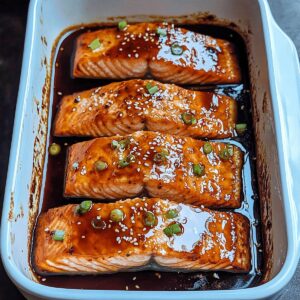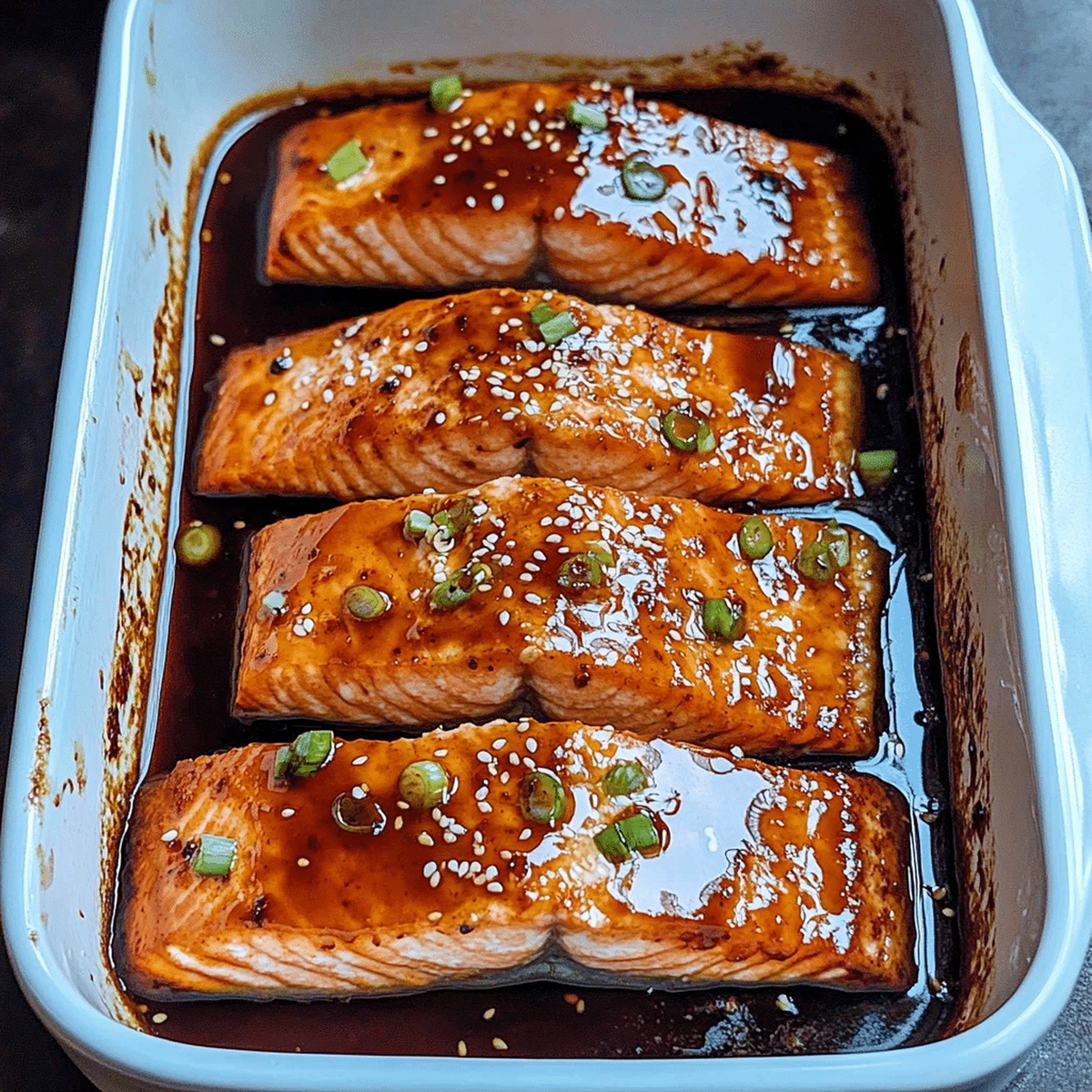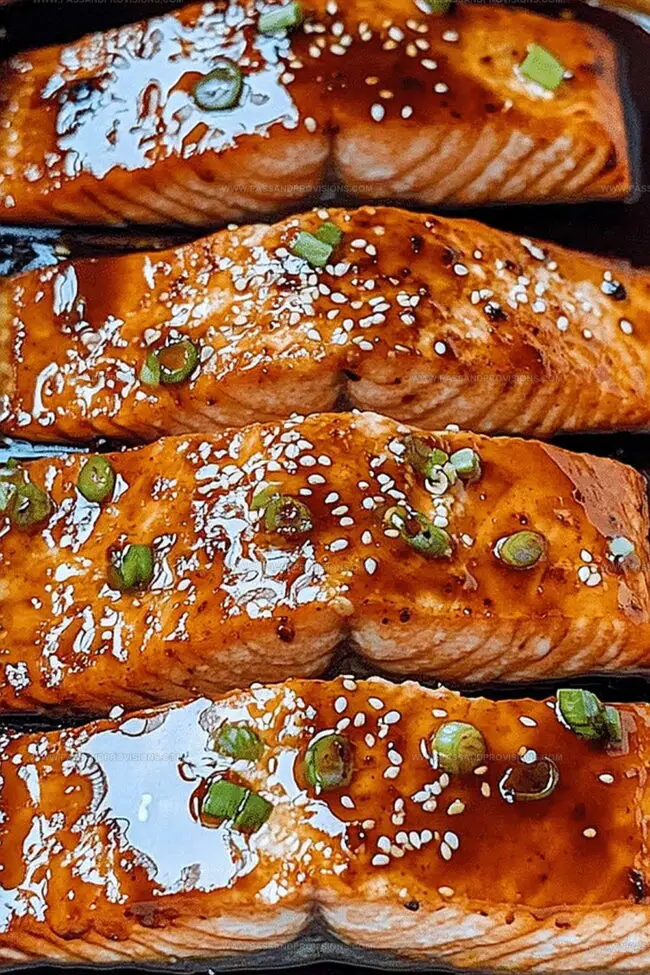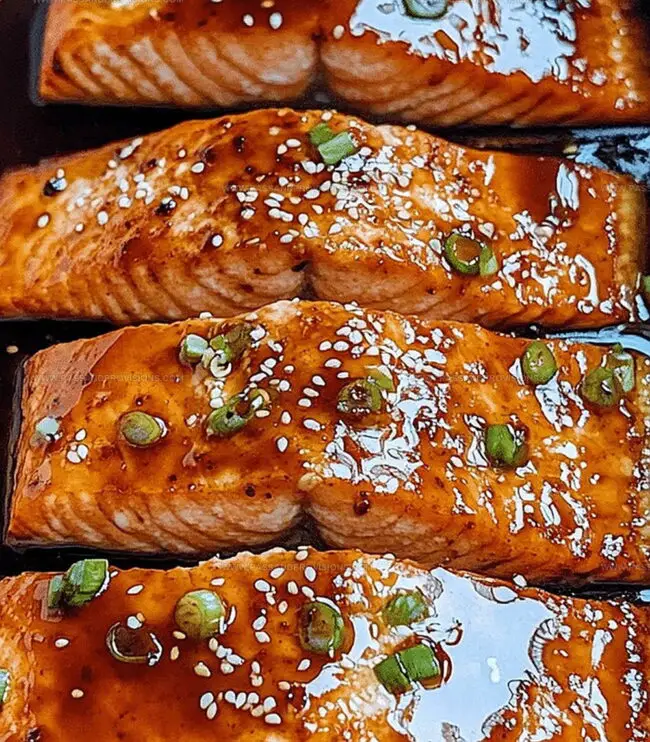Baked Teriyaki Salmon Recipe for Flavorful Simplicity
Crispy salmon with a zesty teriyaki glaze has become my go-to weeknight dinner solution.
Weekends call for something special that doesn’t require complicated techniques.
Home cooking can feel intimidating, but this recipe breaks down every step simply.
Pacific Northwest salmon brings incredible flavor to your plate with minimal effort.
Fresh ingredients make all the difference in creating restaurant-quality meals at home.
Simple marinades transform basic fish into something extraordinary and memorable.
You’ll want to bookmark this foolproof method that guarantees a delicious result every single time.
Why Teriyaki Salmon Is a Foolproof Favorite
What You’ll Need for Baked Teriyaki Salmon
Main Protein:Teriyaki Glaze Components:Garnish and Finishing Touches:How to Bake Salmon That Stays Moist
Step 1: Warm Up the Oven
Fire up your oven to 400 degrees Fahrenheit. Cover a baking sheet with parchment paper or aluminum foil for hassle-free cleanup.
Step 2: Create Flavor-Packed Sauce
In a mixing bowl, blend:Whisk these ingredients until they create a glossy, aromatic mixture.
Step 3: Prepare Salmon for Magic
Arrange salmon fillets on the prepared baking sheet with skin facing down. Lavishly brush the teriyaki concoction over each fillet, ensuring complete coverage. Let the salmon soak up those incredible flavors for 10-15 minutes at room temperature.
Step 4: Transform in the Oven
Slide the baking sheet into the preheated oven. Bake for 12-15 minutes, checking that the salmon becomes perfectly flaky and opaque.
Bonus Tip: For a caramelized exterior, switch to broil for 2-3 minutes. Watch carefully to prevent burning.
Step 5: Add Final Flourish
Sprinkle the baked salmon with:Serve immediately alongside steamed rice, roasted vegetables, or a crisp salad.
Tips for Teriyaki Glaze That Doesn’t Burn
How to Store and Warm Salmon Without Overcooking
Perfect Sides to Match Teriyaki Salmon
Flavor Variations for This Salmon Dish
All the FAQs on Baked Salmon
Teriyaki sauce adds a sweet and savory flavor profile that perfectly caramelizes on the salmon, creating a delicious glaze that enhances the fish’s natural richness.
Both fresh and thawed frozen salmon work great. Just ensure the salmon is completely thawed and patted dry before marinating to help the teriyaki sauce adhere better.
The salmon is done when it flakes easily with a fork and appears opaque throughout. The internal temperature should reach 145F for food safety, and the fish should look moist and tender.
Marinating for 10-15 minutes helps the salmon absorb the teriyaki flavors and creates a more delicious, caramelized exterior. If you’re short on time, you can skip marinating, but the flavor will be less intense.
Print
Easy Baked Teriyaki Salmon Recipe
- Total Time: 25 minutes
- Yield: 4 1x
Description
Succulent salmon meets Japanese-inspired teriyaki glaze in this mouthwatering main dish that promises restaurant-quality flavor with minimal kitchen effort. Home cooks can quickly prepare this delectable seafood meal for a satisfying dinner that will impress family and guests alike.
Ingredients
Main Proteins:
- 4 salmon fillets (6 ounces/170 grams each)
Marinade and Seasoning Ingredients:
- ½ cup (120 milliliters) teriyaki sauce
- 2 tablespoons honey
- 1 teaspoon minced garlic
- 1 teaspoon grated fresh ginger
- 1 tablespoon sesame oil
- 1 tablespoon sesame seeds
Garnish Ingredients:
- 2 green onions, sliced
Instructions
- Transform your kitchen into a culinary sanctuary by positioning the oven rack in the center and elevating the temperature to 400°F (200°C), preparing a baking surface with parchment paper or aluminum foil for pristine cleanup.
- Craft an aromatic teriyaki elixir by whisking together the zesty sauce, golden honey, minced garlic, grated ginger, and fragrant sesame oil in a compact mixing vessel, creating a harmonious flavor profile.
- Arrange salmon fillets with the skin facing downward on the prepared baking sheet, lavishly painting each piece with the teriyaki nectar, allowing the marinade to deeply penetrate and enhance the fish’s natural richness for 10-15 minutes at ambient temperature.
- Slide the salmon into the heated oven, allowing it to roast for approximately 12-15 minutes, monitoring the fillets’ translucency and flakiness as indicators of perfect doneness.
- For an enticing caramelized exterior, activate the broiler during the final moments, watching meticulously to prevent charring and achieve a glossy, appetizing finish.
- Complete the culinary masterpiece by scattering toasted sesame seeds and delicately sliced green onions across the salmon, creating a visually stunning presentation best enjoyed alongside steamed rice or roasted seasonal vegetables.
Notes
- Select thick, fresh salmon fillets with vibrant color for best flavor and texture.
- Pat salmon completely dry before marinating to help sauce adhere and promote perfect caramelization.
- Adjust cooking time based on salmon thickness; thinner fillets need less time to prevent overcooking and drying out.
- For low-carb option, replace honey with sugar-free sweetener and serve with cauliflower rice instead of traditional rice.
- Customize teriyaki glaze by adding red pepper flakes for mild heat or orange zest for citrusy brightness.
- Use high-quality teriyaki sauce or make homemade version for more authentic and controlled flavor profile.
- Prep Time: 10 minutes
- Cook Time: 15 minutes
- Category: Dinner
- Method: Baking
- Cuisine: Japanese
Nutrition
- Serving Size: 4
- Calories: 350
- Sugar: 8g
- Sodium: 800mg
- Fat: 20g
- Saturated Fat: 4g
- Unsaturated Fat: 14g
- Trans Fat: 0g
- Carbohydrates: 12g
- Fiber: 0g
- Protein: 30g
- Cholesterol: 70mg




Jamie Granger
Recipe Developer & Food Writer
Expertise
Education
Culinary Institute of America
Jamie Granger turns ingredients into memories. With her recipes, she brings a fusion-forward flair to every creation.
Her dishes reflect the places she’s explored, the chefs she’s learned from, and the deep connection she has to food as a form of expression.
At Pass and Provision, Jamie develops recipes that balance flavor, health, and beauty, meals that don’t just satisfy your appetite but speak to your curiosity.